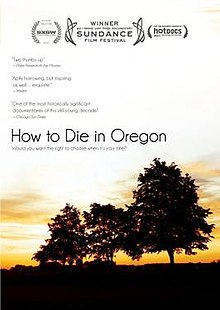“Would you want the right to choose when it’s time?” So goes the tagline for the winner of the 2011 Sundance Film Festival’s Grand Jury Prize for Documentaries.
In 1994 Oregon became the first state in the United States to pass a Death With Dignity law that gave terminally ill patients the option to end their life at a time of their choosing with the concurrence of two physicians. As of 2011 500 people have exercised that option and about 250 have actually taken the life-ending drugs. The rest have died naturally but had the drugs on hand had they chosen to use them.
This is really two stories in one. The first shows us how the Oregon law has worked and is working, and the second is the campaign to have a similar law put in place in the State of Washington.
The Oregon part of the documentary follows several people as they exercise their death with dignity option, but focuses on one particularly heart-wrenching case, that being a 54 year-old woman by the name of Cody Curtis. She was diagnosed with a liver cancer, the only treatment for which was surgery. While she got immediate relief, the cancer eventually returned more aggressively with no more effective treatment possible. When she was told she had 6 months or less to live, she exercised her death with dignity option and put everything in place. Her story takes us on her emotional roller-coaster of plateauing during palliative care – to quote her, she was feeling “quite perky” – to the very quick drop off in feelings of wellness, to the point where she and her loved ones knew it was time.
In Washington Nancy Niedzielski talks about the love of her life, her husband Randy, and his agonizing treatment for, and death from brain cancer. Palliative care service could not provide him the means to end his life, so he was forced to suffer and his wife to witness his slow and painful death. Before he died, Randy extracted a promise from Nancy that she would do all she could to get a death with dignity law in place in Washington. Her efforts took the form of her being a leading advocate for Ballot Initiative I-1000, which called for a Death With Dignity law similar to Oregon’s. You’ll have to watch the film to see the result.
I’m generally in favor of having the death with dignity option in place so it all sounded reasonable to me. However, I have a quarrel with the film’s producers in that they presented almost no pause for concern about such a law, save the case of Oregon resident Randy Stroup. The State of Oregon health authorities denied him coverage for prostate cancer treatment because his 5-year survival prognosis was poor. However, they said they would cover the cost of the death with dignity option, which would be much less expensive. This raises an important question. Will governments and private insurance companies continue to pay for treatments that have a poor prognosis when a much less costly option is in place? To put it bluntly: treatment is expensive; death is cheap.
I recommend that you also watch at least one deleted scene: that of Dr. Charles Bentz, an Oregon physician who has exercised his choice to not participate in the death with dignity option. Instead, he is a strong advocate for improved end-of-life care. While his interview has overtones of persecution, his is a voice that ought to have been heard in the main documentary.
